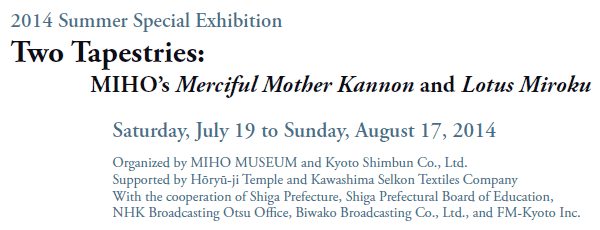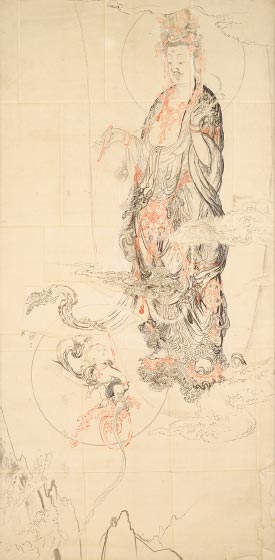
MIHO MUSEUM owns two contemporary masterpiece tapestries: MIHO’s
Merciful Mother Kannon (dated 1994), modeled after the painting
Merciful Mother Kannon (Skt. Avalokiteśvara) by the Meiji-period
Japanese painting giant Kanō Hōgai (1828–1888), and
Lotus Miroku
(dated 2012), based on mural painting no. 2 of Miroku (Skt.
Maitreya), holding a lotus and sitting with one leg pendant, from
Hōryū-ji Temple’s main hall that was destroyed in a fire in 1949,
and woven by Kawashima Selkon Textiles Company. The current
exhibition presents the two works together for the first time.
This exhibition also explores the origins of the two iconographies and includes underdrawings (from Kawashima Selkon Textiles Museum) and other materials pertaining to the two tapestries that have been restricted to general access, while showcasing these tapestries, which represent the apex of weaving technology today, together with renowned Buddhist art such as images of Willow Kannon and Buddhist deities sitting contemplatively with leg pendant from Japanese and overseas collections.
Moreover, all twelve reproductions of the mural paintings from Hōryū-ji Temple’s main hall will be on exhibit here. The mural reproductions (which are owned by the Museum of Hōryū-ji Mural Reproductions of the Aichi University of the Arts) took fourteen years, under the auspices of the Aichi University of the Arts and headed by the Japanese painter Kataoka Tamako (1905–2008), and were completed in 1987.
This exhibition also explores the origins of the two iconographies and includes underdrawings (from Kawashima Selkon Textiles Museum) and other materials pertaining to the two tapestries that have been restricted to general access, while showcasing these tapestries, which represent the apex of weaving technology today, together with renowned Buddhist art such as images of Willow Kannon and Buddhist deities sitting contemplatively with leg pendant from Japanese and overseas collections.
Moreover, all twelve reproductions of the mural paintings from Hōryū-ji Temple’s main hall will be on exhibit here. The mural reproductions (which are owned by the Museum of Hōryū-ji Mural Reproductions of the Aichi University of the Arts) took fourteen years, under the auspices of the Aichi University of the Arts and headed by the Japanese painter Kataoka Tamako (1905–2008), and were completed in 1987.
The MIHO’s Merciful Mother Kannon corner will also focus on
the original Merciful Mother Kannon painting by Kanō Hōgai.
Imagine how the composition of this masterpiece was created
and what kind of sentiments Hōgai had making this work.
|
 |

The occasion for the creation of this image is said to have
been the birth of Hōgai’s first grandchild. The reality that
Hōgai apparently saw, however, was a mother standing behind
a child, who points towards some discovery, which he appears
to be trying to share with his mother. The painter replaced
the mother image with Kannon holding a willow branch. Hōgai may have chosen Willow Kannon when he drew his first grandchild with a Kannon image in hopes of strength for curing all illnesses and nurturing life with the symbol of the willow and water vase that this deity originally held as well as for his grandchild to grow up healthy. This painting of Kannon can also be compared to images of Mother and Child. |